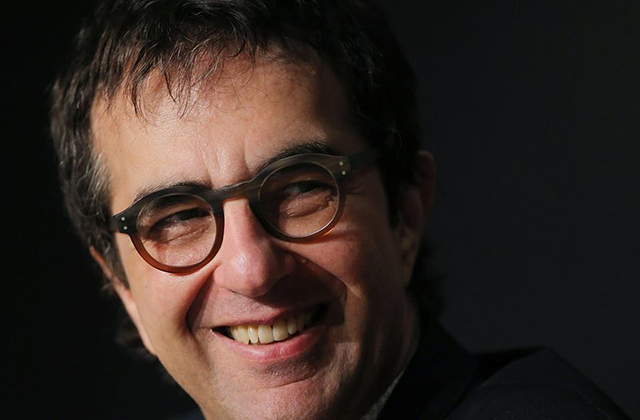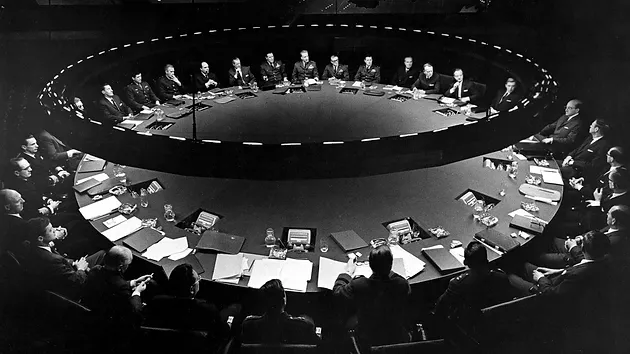
The perfect scene Dr. Strangelove’s war room

What is the perfect scene? For award-winning filmmaker Atom Egoyan, it’s the “war room” from Stanley Kubrick’s Dr. Strangelove. We asked him to set the scene for us – and tell us why.
AE: Dr. Strangelove was made at the height of the Cold War. At this point, the prevailing attitude in preventing all out war between the Soviet Union and the United States was the concept of MAD. This was the term thrown about for “mutual assured destruction,” and it suggests that the only reason these two super-powers didn’t come to blows is because they both knew they could wipe each other off the planet. In other words, a simple and effective little deterrent which nonetheless meant that the only way to sustain a psychological war was to build up more and more effective tools of mass destruction. The dark absurdity of this race towards oblivion is perfectly captured in this fantastic set by production designer Ken Adams. It all culminates in the final scene in this “war room,” when Peter Sellers — playing three wildly different characters in this brilliant film — has a seizure in which his arm tries to make a spastic Nazi salute to his very dead leader.
CA: What were the important artistic choices Ken Adams made — or avoided — in achieving the mood of the scene? And how would you describe that mood, anyway? Re-watching these “war room” scenes, we’re not sure if we’re supposed to laugh or be terrified.
AE: What’s astonishing about the scene is Ken Adams’s choice to use an expressionist and highly stylized approach in what is essentially a location-based and realistic world. Compare the grittiness and hand-held approach of the seizure of the military base with what happens in the war room. Of course, this all emanates from Stanley Kubrick’s singular vision, but I maintain the design of the war room is one of the most successful set pieces in cinema. The careful harnessing of lunacy, despair and fear is perfectly realized. We are horrified and completely engrossed in the sheer intensity of what is at stake. The balance between atrocity and glamour is unique. And to cap it off we have one of the best lines ever: “You can’t fight in here! It’s the war room!”

CA: It’s becoming clear that when we say the “war room” scene, we’re actually referring to a few different scenes from various parts of the movie — but all of them taking place in the same war room. It’s interesting that they’ve been filed away in our memories as a single unit.
AE: That’s a fascinating concept, the way in which we reformat films in our memory long after we’ve watched them. It’s inevitable. Film scenes are constantly reshuffled and re-ordered during the process of editing, and there’s an argument that when a film has made a huge impression — the way Dr. Strangelove has certainly impressed me — we concentrate and expand various aspects according to our own intellectual and emotional needs at any given time. We conflate, bend, and distort the film to make it our own, and this is what great cinema invites us to do.

CA: Let’s talk about the acting. It’s intense, sometimes outlandish. You mentioned Peter Sellers as Dr. Strangelove going on a 60 second improvisational self-grabbing spree. Tell us a little about the art of giving an actor direction versus freedom.
AE: That’s a great question. What I love about Peter Sellers’s performance in what you call the “self-grabbing spree” is that it feels like the camera is watching this happening for the first time. If you look closely, you can see that the actor playing the Russian Ambassador can’t control himself. He’s about to break out laughing at Sellers’s spectacular performance! There are moments when a director knows that an actor truly owns their performance. They were literally born to play something, and the best you can do is let them loose.

CA: Tell us why this scene works from the perspective of what Kubrick doesn’t do — or doesn’t try to do. We notice there is no music, for example. What else isn’t there?
AE: Kubrick is completely confident in mixing tones and choices that would simply not work with a less brilliant and daring director. He has a reputation for being a control freak, but he knew his lenses and artistic arsenal like no one else. Every gesture, every move is beautifully realized and we completely trust his choices. I never understand when some viewers call his work cold or calculating. He’s second only to Hitchcock in his complete mastery of the medium.
CA: Hitchcock, of course, would no sooner allow a 60 second improvisation than cast a redhead as his female lead! Speaking of which, we can’t help but notice the lack of women in the war room — or in the film. Do you think the absence of sexual chemistry has purpose? Are we meant to save our feelings for the bomb?
AE: The whole room is designed to be a giant womb, so I think the fact that all these ridiculous men are encased in such a feminine symbol is quite powerful. Just look at the mating ritual during the title sequence (the release of the missile looks like two praying mantis’ having sex) and you’ll see that the film is actually introduced with sexual imagery.
CA: Purely for fun, how do you think a less nuanced director might have spoiled this perfect scene?
AE: If you’re asking me how I would have spoiled this scene, you’re being very cruel!























